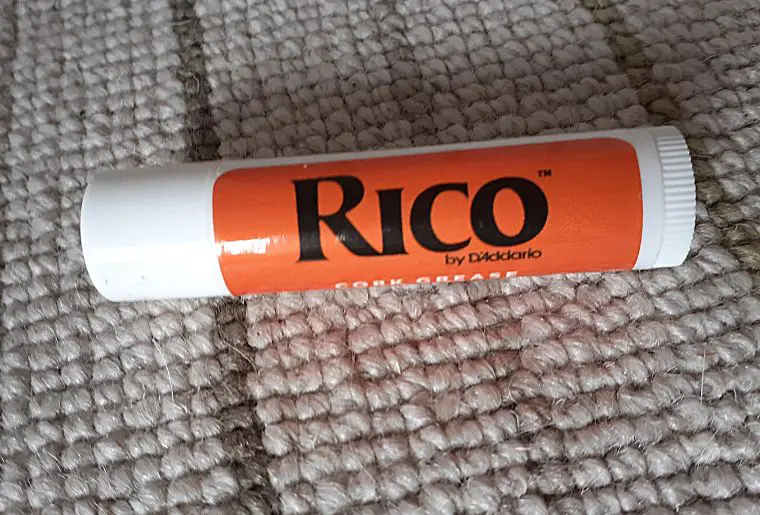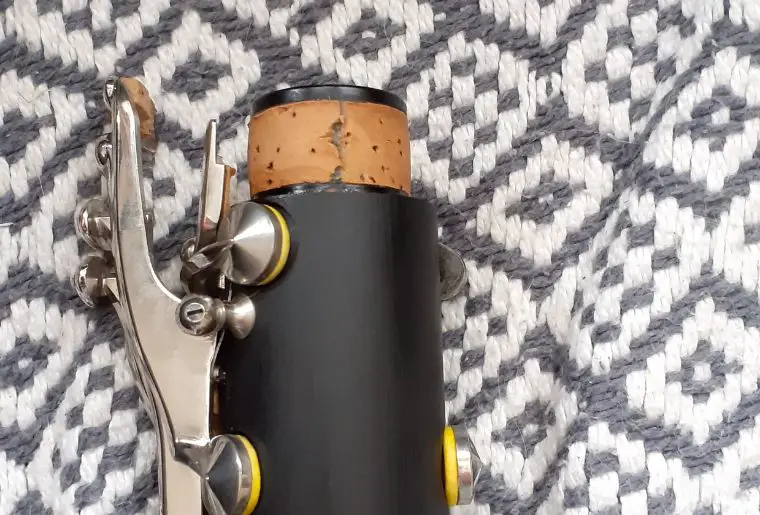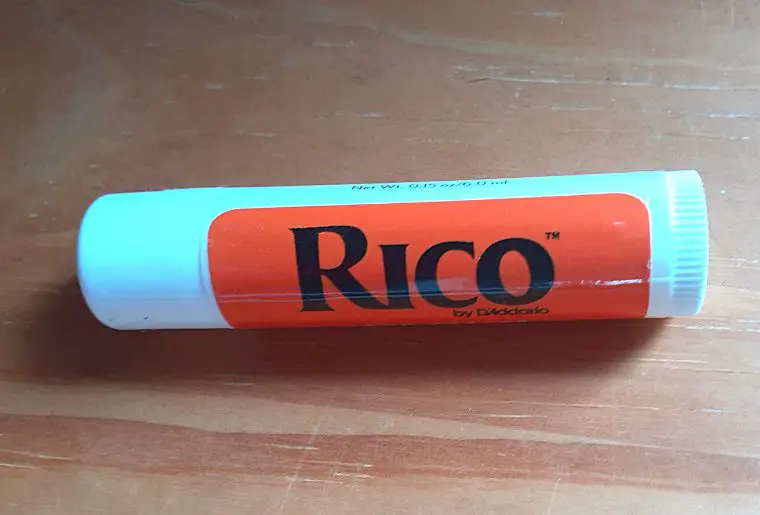The typical nature of the clarinet is that it gets drier and stiffer as you keep playing. During my initial stages of playing the clarinet, I found it hard to assemble the instrument, especially when it gets completely dried up. Over time, my teacher explained cork grease’s significance, which made things easier.
Cork grease is used to improve the clarinet corks’ moisture so that the cork lasts longer and doesn’t crack and break. It is best to use grease that is designed for the clarinet, however, there are alternatives you can use such as vaseline, lip balm, and coconut oil.
As a clarinet learner, I’d recommend you use cork grease to soften the cork and make it sound better. When your clarinet soaks in this grease, it reduces the probability of getting dried up. Sounds interesting, right?
Let us take a look at how a cork grease functions, the best cork grease for clarinet in the market, and some alternatives to cork grease in this article.

What Is Cork Clarinet Cork Grease
Cork grease is an asset to every clarinet player as it improves the cork’s moisture and lets it flow smoothly without breaks or cracks in the middle. It is also a lubricant meant to lengthen the life of the joint cork.
According to Dawkes Music, woodwind instruments contain cork joints that experience low moisture as players play them regularly. In these cases, a dry cork does not yield the desired music. As a result, you need to grease it regularly to protect joints and improve sound quality.
How To Apply Clarinet Cork Grease To Your Clarinet?
Applying cork grease to a clarinet needs proper knowledge and skill. If it goes wrong, it does not increase moisture and damages the quality of sound in the long run. So, when to apply cork grease to a clarinet? When you find difficulties in assembling the instrument, you need cork grease to add ease to the structure, according to Paul Effman Music Store.
Follow the steps below to apply cork grease appropriately.
- Take a small portion of grease and apply it to the surface of the cork.
- Gently spread the grease on the upper and lower joints of the cork.
- As you apply the grease, the moisture increases, and you can feel the softness on the surface.
- After playing for the day, wipe the cork and get it grease-free.
What if you still find both ends tight? In that case, you need the guidance of a band director to help you or go to your nearest clarinet repair professional to check if the clarinet needs a minor repair.
This could be a case if you are using an old clarinet. The process of applying cork grease changes significantly based on the age of the clarinet.
This video from Youtube shows you how.
For a new clarinet
You need to apply cork grease for a new clarinet before you assemble the clarinet.
In this case, the moisture stays longer and does not need you to grease each time. However, do not let it go loose by applying too much grease to the clarinet.
For a used clarinet
For a used clarinet, you need to apply cork grease regularly as and when you feel the moisture is down.
If the clarinet is too old, you need to take the help of an instrument technician. The technician might repair the cork and replace it based on the condition.
Nevertheless, the clarinet needs to be regularly greased to produce tones as expected.
If you have any doubts about how important cork grease is, this is what happens when it’s not used: When I bought a 2nd hand clarinet to replace my hire the previous owner hadn’t used cork grease. This resulted in dried-out corks. My clarinet didn’t really play and makes an awful sound. I’ve had to buy new corks and get them to put onto the clarinet.
While replacement corks aren’t that expensive it’s a real pain for a beginner to put them onto the clarinet.
See my clarinets damaged cork below:

Great Alternatives To Cork Grease
While cork grease is a great lubricant for your clarinet, there is a constant search among players for alternatives to it. Are there alternatives? Do they work the same way as a cork grease?
An unscented and natural lip balm, free from flavors, is the best alternative to cork grease. Lanolin is another alternative that spreads smoothly but comes in a different consistency. If you are new to it, you might find it difficult to spread it evenly.
There are common ideas about cork grease substitutes. Let us review every product and evaluate if it is a healthy substitute or not.
1. Vaseline
Vaseline is a commonly used alternative to cork grease. It is cost-effective and easily available on the market.
Several users of Vaseline find that Vaseline keeps the clarinet moisturized for a long time. Further, this is also a lot easier to use than cork grease.
The downside of Vaseline is that it can hold the cork together with its glue, which can eventually stop the instrument from functioning correctly.
Verdict – Hence, a petroleum jelly like Vaseline cannot be a cork grease substitute.
2. Lip balm
Lip balm is a commonly used substitute for cork grease. Right from the texture to the product itself, it matches those of cork grease.
The downside with a lip balm is that the moisture effect is for a short period. This means the clarinet can dry faster. As a result, you have to use the lip balm regularly on your clarinet. This may leave a strong residue, thereby affecting the cork in the long run.
Verdict – An unscented, unflavored lip balm can be treated as a temporary alternative to cork grease, but it cannot be used for long due to its poor lubrication capacity.
3. Coconut oil
When you think of lubricants, coconut oil is the first thing that could come to your mind.
While coconut oil helps improve moisture levels, it is sticky and can cause trouble while you play the clarinet.
With its strong odor, it can also deteriorate the quality of the woodwind instrument over time.
Verdict – Coconut oil is not an efficient alternative to cork grease.
4. Lanolin
Lanolin is extracted as wax from sheep and is used as an ingredient for cork grease. While it is packaged differently, it has all the consistency and properties of cork grease.
The only downside with Lanolin is that it is not widely available. Hence, when your clarinet is used to this form of lubricant, you need to store it in bulk.
I have seen many of my friends using lanolin oil instead of cork grease, and the quality and sustainability of the instrument are satisfactory.
Verdict – Lanolin can be considered a wonderful alternative to cork grease.
5. Beeswax
Beeswax works as a lubricant and is used to make several cosmetic products. How about using it for clarinet? Due to its sticky nature, you cannot use beeswax directly. However, you can mix it with lanolin oil or coconut oil to give it the perfect texture.
A good mix is the combination of lanolin oil and beeswax. This combination stays longer and keeps your clarinet sweeter and more efficient.
Verdict – Do not use beeswax in its raw form as a substitute for cork grease.
The Best Clarinet Cork Grease
Every clarinet player needs a cork grease. While you can make your own cork grease at home, it is not practical for all. Here are a few product recommendations based on my personal use.
1) Vandoren CG100B Clarinet Cork Grease
You can find Vandoren cork grease in the pockets of most clarinet players. This is because of its outstanding quality and its presence in the market for years.
Sold in the form of a glue stick or a roll-on, it lubricates and maintains the cork airtight. I can call Vandoren cork grease value for money as it gets the job done perfectly and smells like apple.
When using the Vandoren, you may have to grease it less frequently as it is solid and does not melt. The problem with the majority of cork greases is the unpleasant smell.
2) Instrument Clinic 100% Lanolin Cork Grease
Lanolin-based cork grease is an absolute steal if you are looking to moisturize the cork of your clarinet. The lanolin cork grease from Instrument Clinic is sold in 3 jars of 0.25oz each. It is good to buy it in bulk since it is less available.
Whenever my original cork grease gets over, I have always chosen lanolin cork grease. I do not find any significant difference in how it works on the clarinet. I have observed some of the common positives: easy application, value for money, non-sticky nature, and suppled cork.
If you are new to lanolin-based cork grease, it might take time to get used to this consistency. Otherwise, this is a must-buy for each clarinet player.
3) Cork Grease for Woodwind Instrument
Beeswax, combined with regular cork grease, is a fantastic product to purchase for your clarinet. The cork grease from Duo Korea is available in a pack of 2 pieces and in two colors – yellow and green.
There are several benefits to this product.
- It gels well despite high temperatures, and it does not melt.
- It is soft and safe to use.
- It is natural and easy to use on the instrument.
- It is fairly cost-effective.
As I come from a family of musicians playing multiple woodwind instruments, I buy cork grease that fits all the instruments. This cork grease from Duo Korea fitted the expectation.
4) 6 Pieces of Cork Grease for Clarinet Flute Grease Lubricant Tube
If you are looking to extend the lifespan of your clarinet, this is the product to buy. It is always a good idea to stick to an accessory as it maintains the quality and is easy to troubleshoot whenever it encounters errors.
This cork grease comes in a pack of 6 pieces, and it is sufficient for several months, although you are a regular clarinet player. The lubrication effect is mindblowing. I have used this cork grease quite a few times and was pleased by its ability to protect the cork for a long time.
It also comes with a product user manual. So, it gets easier to use it on various woodwind instruments. The best part about this product is the ability to develop a protective coating on the cork’s surface. This product works great for an old clarinet as well.
5) Monster Clarinet Care and Cleaning Kit
If you have a beginner clarinet player at your home, you need to gift them this clarinet care and cleaning kit from Monster Oil. It is good to teach the newbie the perfect way to maintain the clarinet during the early stages. This will last longer.
So, what does this kit contain? It contains cork grease, thumb rest, pad drying paper, microfiber cloth, fingering chart, pencil, and cleaning instructions. My teacher has recently recommended this type of complete kit to new clarinet players. I find this a great idea as it is complete, and the player learns to keep the clarinet clean.
The cork grease from this package glues well with the cork and avoids potential damages to the cork. With the cleaning cloth inside the pack, it is feasible to clean the cork after each practice session.
Another advantage of this product is that it is kid-friendly. Even if you gift it to your daughter or son, he/she will use it without safety issues.
6) Rico Cork Grease
Rico is a popular cork grease. You use it to help put the instrument together, and to keep the corks in good condition. It also helps seal the gaps keeping sound in the instrument. It is easy to use and is like a lip balm pop-up tube.
I’ve had great results with Rico. (Pictured here and above).
Conclusion
When you use cork grease for your clarinet, go with the standard product that instructors and experts in the market approved.
As you cannot skip this lubricant, you should either go with the regular cork grease or use lanolin oil or other products mentioned in this article.
The goal behind using the perfect cork grease is to safeguard the cork and improve the instrument’s longevity with simple, easy-to-follow routines.
Happy greasing and maintaining your clarinet!
